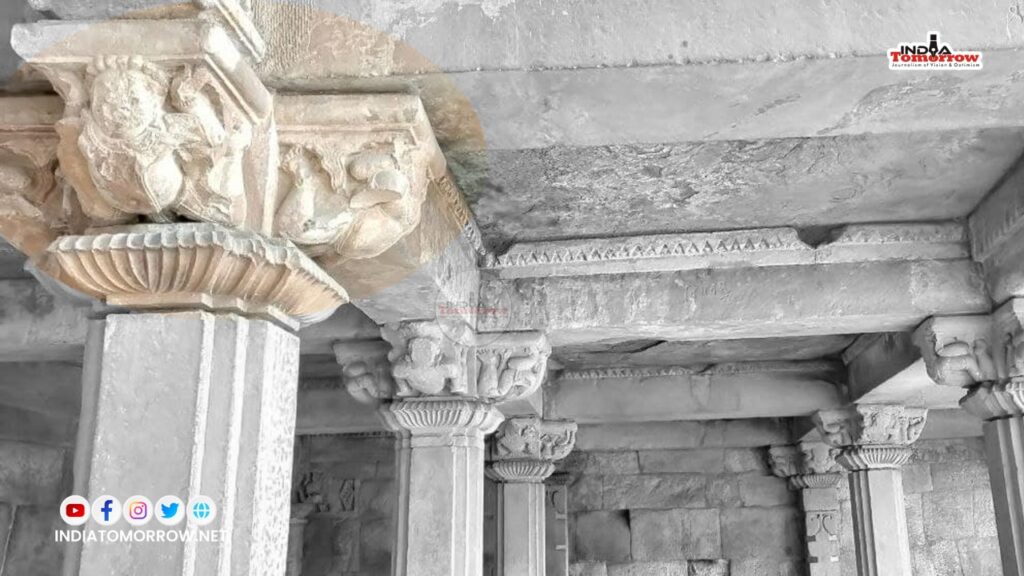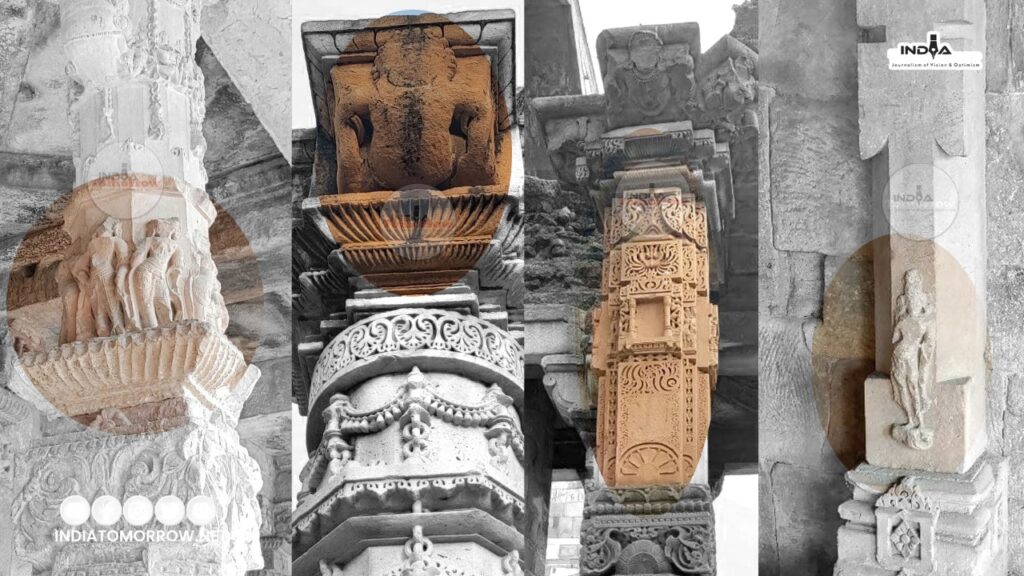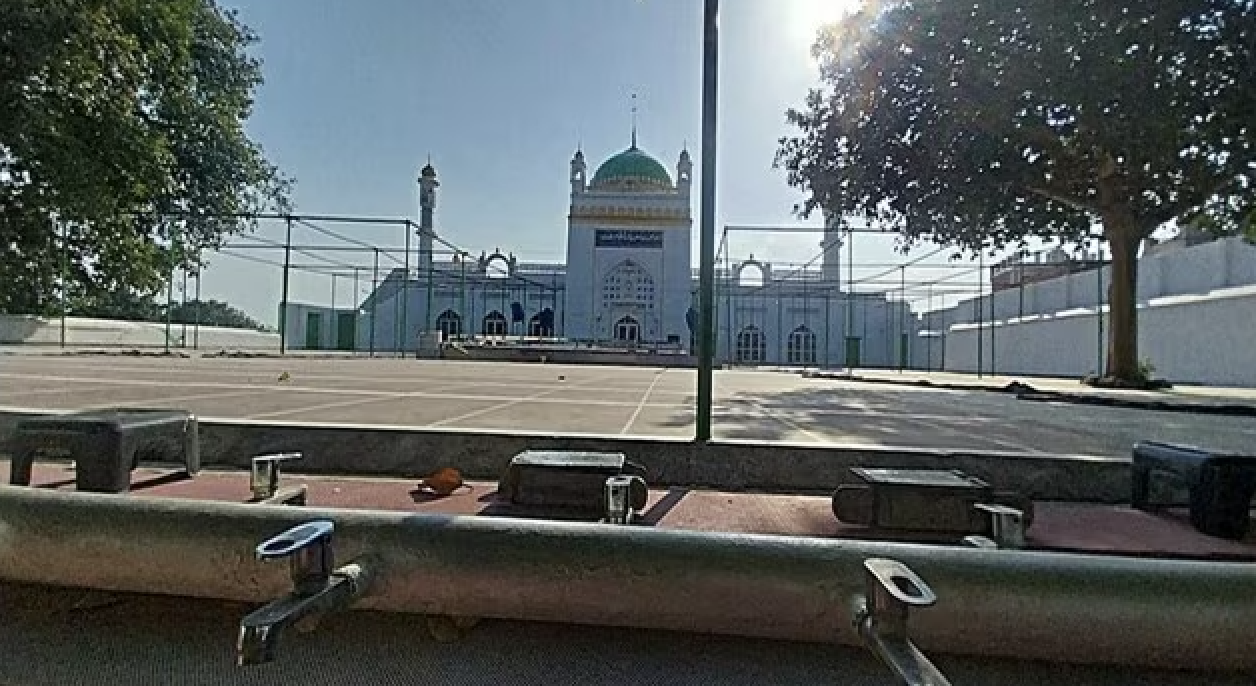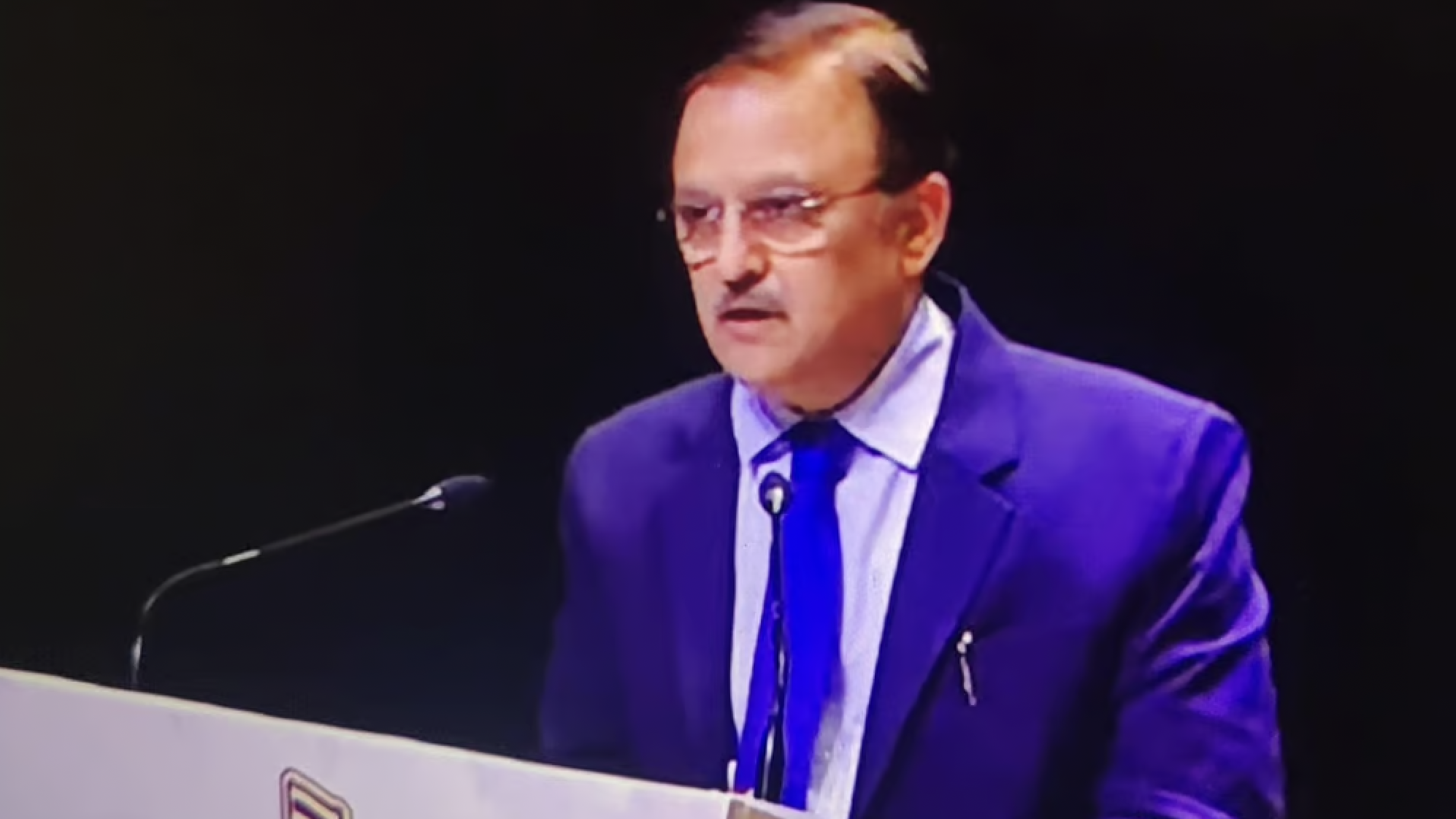By Syed Khalique Ahmed / India Tomorrow
NEW DELHI—A Delhi court on Wednesday directed the Archaeological Survey of India not to remove the Ganesh idols from the Quwwatul Islam mosque, or what is popularly called the Qutub Minar complex.
A few days ago, National Monument authority (NMA) had asked the ASI to retrieve the idols from the Qutub Minar complex and shift them to the National Museum. NMA is headed by Tarun Vijay, a BJP leader.
In December 2021, the Saket court had rejected a petition that had sought restoration of the so-called temples within the Quwwatul Islam masjid complex.
Conspiracy of the right-wingers
However, the entire exercise appears to be a conspiracy of the right-wingers to capture the Qutub Minar complex through a court verdict on the lines of the Babri Masjid.
The Archaeological Survey of India (ASI), whose job is to preserve and protect the originality of monuments, appears to have secretly changed the interiors of the mosque thus preparing the ground for the right-wingers to claim the mosque as temple.
If one visits the complex, which is basically the Quwwatul Islam Mosque complex, and Qutub Minar is a part of it but standing the tallest, one will see how the ASI is replacing old and plain stones with new stones sculptured into human figures that are distinguishing features of a Hindu or a Jain temple in India.
The Minar was used to give ‘Azaan’ (call for prayers) to ensure that the call for ‘namaz’ reaches as far as possible.
This is all being done on the pretext of conservation and protection of the religious structures within the Quwwatul Islam Mosque complex. It does not require expertise to decipher what the ASI is doing in the complex. Even a layperson can understand that it is changing the very character of the buildings, destroying its pristine identity, and not doing anything to protect its originality, the most basic function assigned to the ASI.
Replacing plain stones with stones carved with human figures
While most of the mosque has disappeared despite it being under the ASI protection, a covert operation is gradually on to insert stones carved with figures by removing the plain stones on top of pillars touching the mosque’s ceiling. So, some of the rocks on top of the pillars have images. The rest are plain and simple, with no images at all. This is against the symmetry practiced in all construction to give the building elegance and uniformity in designs. The change in uniformity of structures by inserting stones with figures indicates desecration being done on the pretext of conservation and protection.
There are still about 50 pillars in the inner portion of the mosque and almost double the number of it in outer verandahs that are part of the extended mosque. The mosque is based on the pattern of mosques built by Afghan rulers in Ahmedabad and other Gujarat cities under Afghan rulers before Akbar captured Gujarat. The Quwwatul Islam Mosque was built by Qutbuddin Aibak, army commander of Mohammad Ghouri, an Afghan ruler, and hence, it bears prominent similarities with Afghan architecture. Ghouri captured Delhi in 1192 but left for Afghanistan within a few months, leaving Delhi in charge of Qutbuddin Aibak. The period in Delhi that began with Muhammad Ghouri is known as the Sultanate period in history.
Stone figures rubbed or mutilated to make it look like old material
To ensure that the mischief goes undetected, the figures on stone pieces have been rubbed and truncated to make it look like an old material. But a meticulous and detailed look clearly distinguishes the two types of stones: the old ones without images and the other one desecrated with images.
The ASI conservators, who have worked on the mosque complex, have also replaced some of the vertical stones in the pillars with human figures. But, again, there is a stark difference in the colour of the stones carved into figures and those without figures. A careful look shows that stones with figures are new ones. But here as well, care has been taken to present it as old material by rubbing or mutilating the figures.
Surprisingly, such human figures or images are not there on any of the pillars or walls on the mosque’s exterior. So how did the figures appear on pillars inside the mosque? There are also no figures even on the walls inside the mosque.
The presence of figures under any circumstances is not allowed inside a mosque because that is against the fundamental tenets of Islam.
And when a mosque is being constructed as Quwwatul Islam, meaning “Might of Islam” by a Muslim ruler, can he commit such a blunder? Will Muslims pray in such a mosque, whether for a day or hundreds of years? Anybody knowing the basics of Islam will say straight “No”.
Even if it is accepted for the argument’s sake that the rulers were in a hurry to construct the mosque to demonstrate their victory and hence, they used the materials from the demolished temples, materials with human or animal figures would have been used only on the exterior and never in the interior.
No logic in the ASI argument on the use of temple material in Masjid
So, the big question is: Why temple materials with human figures were used inside the mosque and not outside? If temple material was used as per ASI argument inside the mosque, what prevented its use outside. Using it in outer walls would not have created any problem for those performing namaz inside the mosque. Hence, there seems to be no logic in claims that temple material was used in mosque construction. Moreover, it took about six years to complete the mosque. This information is provided in a book titled “World Heritage Series: QUTB MINAR & Adjoining Monuments,” published by ASI and being sold inside the Qutub Minar complex. According to the book, Mohammad Ghouri captured Delhi in AD 1192 (pp 30), and the mosque construction was started by his army general Qutbuddin Aibak soon after the victory.
The mosque was completed in 1198, as mentioned on Page number 34 of the book. When it took six years to complete a mosque, was it impossible to arrange building materials in 72 months when Muhammad Ghouri and Qutbuddin ruled from Delhi to Afghanistan? The ASI arguments seem to be nothing but a bundle of fallacy to prove a predetermined right-wing agenda.
The ASI is trying to substantiate its claim from Ibn-e-Batuta’s travelogue. World Heritage Series claims Archaeological Survey Reports, Volume IV, pp.46, as its source. According to the book, Ibn-e-Batuta, an Arab traveller, wrote that the place where the Quwwatul Islam mosque stood had been a Hindu temple, and Hindus called the place elbut-khana.
But the word ‘elbut-khana’ is a Persian-sounding word, not Sanskrit, Pali, or Hindi. Why would Hindus call their temple ‘elbut-khana’ when Persian was not in use in this part of the world? Persian was introduced in India only in the 12th century with conquest by Afghans. So, the argument of the ASI is not based on sound logic. It looks like an extrapolation. Moreover, ASI must provide the page numbers of Batuta’s travelogue where he has made a claim and supply information about its publishers and year of publication. They should reveal the language of the Batuta’s travelogue from which the ASI has sourced its information.
While almost all the vertical stones, except those desecrated with images, used in pillars are similar in colour, one vertical stone in the corner of the mosque is dark saffron-red, the kind of colour generally found in temples. At many places, grabbers of mosques and other Muslim religious properties have used this technique to prove that the structure is a part of the temple. After some time, the usurpers, with support from sympathetic elements in the government and security agencies, begin ‘pooja’ and other activities as happened at Hyderabad’s Charminar and Vadodara’s Mandvi Gate.
ASI desecrating Qutub Minar
Another example of a prominent and intentional bid to alter the status of the Quwwatul Islam mosque is to change the originality of the Qutub Minar itself. The diameter of the Minar has calligraphies of Quranic verses at different floors and different heights. The stones with Arabic calligraphies almost a metre above the base of the Qutub Minar have been replaced with plain stones. At one level, the conservators have covered part of the calligraphies with simple stones, and the rest of the calligraphies are still intact. But one cannot understand the full meaning of the calligraphies because some of the calligraphies have been removed and replaced with plain stones. This is a massive desecration of world heritage.
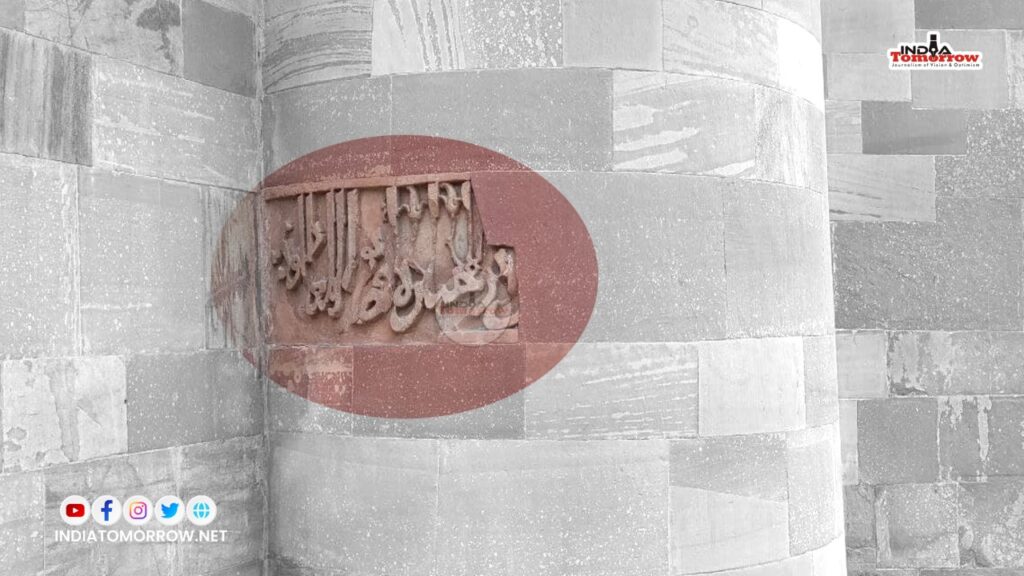
Original stones, stones with Arabic calligraphies strewn all over the Qutub complex
The original stones, including some of the stones with Arabic calligraphies from the Qutub Minar are strewn all over the complex, most of them dumped behind the Iltutmish’s Makbara (tomb of Iltutmish) and on the sides of a graveyard adjoining the ‘makbara’, indicating how the conservators are neglecting the monument and altering the originality of the UNESCO World Heritage Site that draws the largest number of domestic and world tourists.
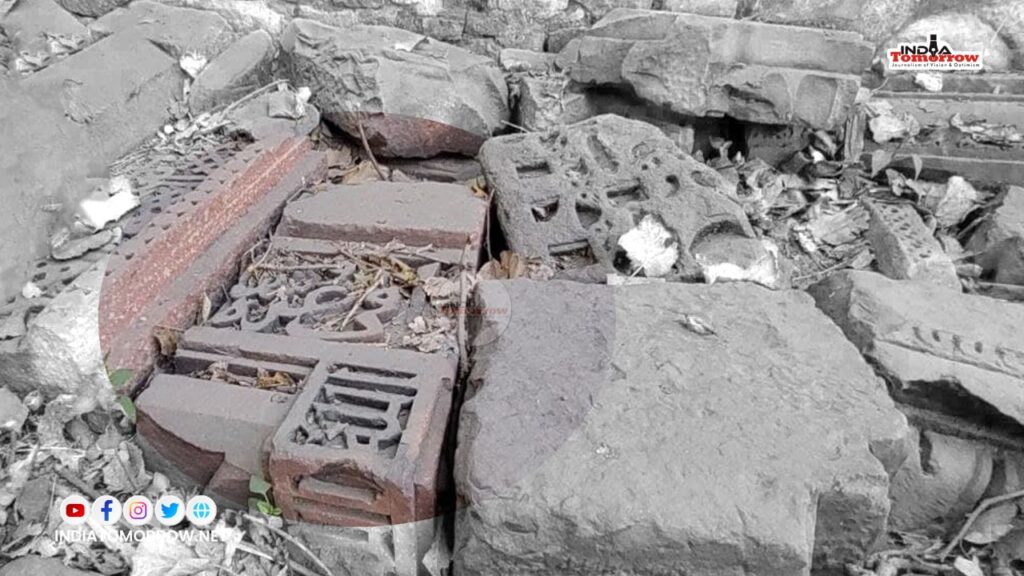
The rooms of the ‘madrasa’ inside the complex, which was the school for students, are stinking with urine, reflecting on the poor upkeep of the world heritage site. The gardens inside the complex are also not properly maintained. In addition, the washroom and toilets in the complex meant for tourists are not in working condition.
‘Guide’ or ‘Misguide’
Prabhash, the guide that the India Tomorrow team hired, instead of telling us about the mosque and other buildings, tried to convince us that it was a temple. Instead of guiding and telling us about the mosque and how it was built, and how many years it took to construct it, he was ‘misguiding’ us. He was explicitly showing us the figures on the pillars and their top touching the ceiling. He had no answer about why there were no figures on the exterior of the mosque. He also did not answer why the Arabic calligraphies just a metre above the base level of the Qutub Minar were destroyed and covered with plain stones. He said it is for the ASI to answer this question.
All efforts to get answers from ASI officials failed. ASI Public Relations Officer (PRO) Manu Sharma said, “Mail us your questions. I will forward them to Superintending Archaeologist, Delhi, to get the answer.”
This article first appeared on indiatomorrow.net



